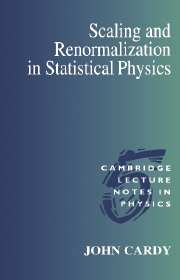Book contents
- Frontmatter
- Dedication
- Contents
- Preface
- 1 Phase transitions in simple Systems
- 2 Mean field theory
- 3 The renormalization group idea
- 4 Phase diagrams and fixed points
- 5 The perturbative renormalization group
- 6 Low dimensional Systems
- 7 Surface critical behaviour
- 8 Random Systems
- 9 Polymer statistics
- 10 Critical dynamics
- 11 Conformal symmetry
- Appendix: Gaussian Integration
- Selected Bibliography
- Index
1 - Phase transitions in simple Systems
Published online by Cambridge University Press: 05 February 2015
- Frontmatter
- Dedication
- Contents
- Preface
- 1 Phase transitions in simple Systems
- 2 Mean field theory
- 3 The renormalization group idea
- 4 Phase diagrams and fixed points
- 5 The perturbative renormalization group
- 6 Low dimensional Systems
- 7 Surface critical behaviour
- 8 Random Systems
- 9 Polymer statistics
- 10 Critical dynamics
- 11 Conformal symmetry
- Appendix: Gaussian Integration
- Selected Bibliography
- Index
Summary
Take a large piece of material and measure some of its macroscopic properties, for example its density, compressibility or magnetisation. Now divide it into two roughly equal halves, keeping the external variables like pressure and temperature the same. The macroscopic properties of each piece will then be the same as those of the whole. The same holds true if the process is repeated. But eventually, after many iterations, something different must happen, because we know that matter is made up of atoms and molecules whose individual properties are quite different from those of the matter which they constitute. The length scale at which the overall properties of the pieces begin to differ markedly from those of the original gives a measure of what is termed the correlation length of the material. It is the distance over which the fluctuations of the microscopic degrees of freedom (the positions of the atoms and suchlike) are significantly correlated with each other. The fluctuations in two parts of the material much further apart than the correlation length are effectively disconnected from each other. Therefore it makes no appreciable difference to the macroscopic properties if the connection is completely severed.
Usually the correlation length is of the order of a few inter-atomic spacings. This means that we may consider really quite small collections of atoms to get a very good idea of the macroscopic behaviour of the material.
- Type
- Chapter
- Information
- Scaling and Renormalization in Statistical Physics , pp. 1 - 15Publisher: Cambridge University PressPrint publication year: 1996



